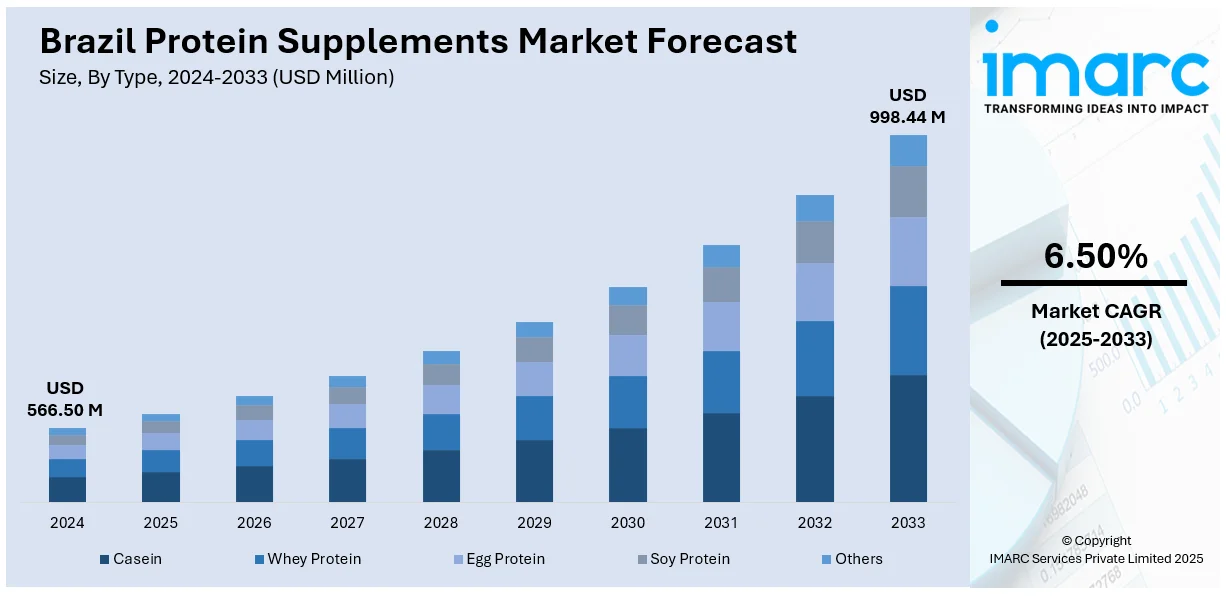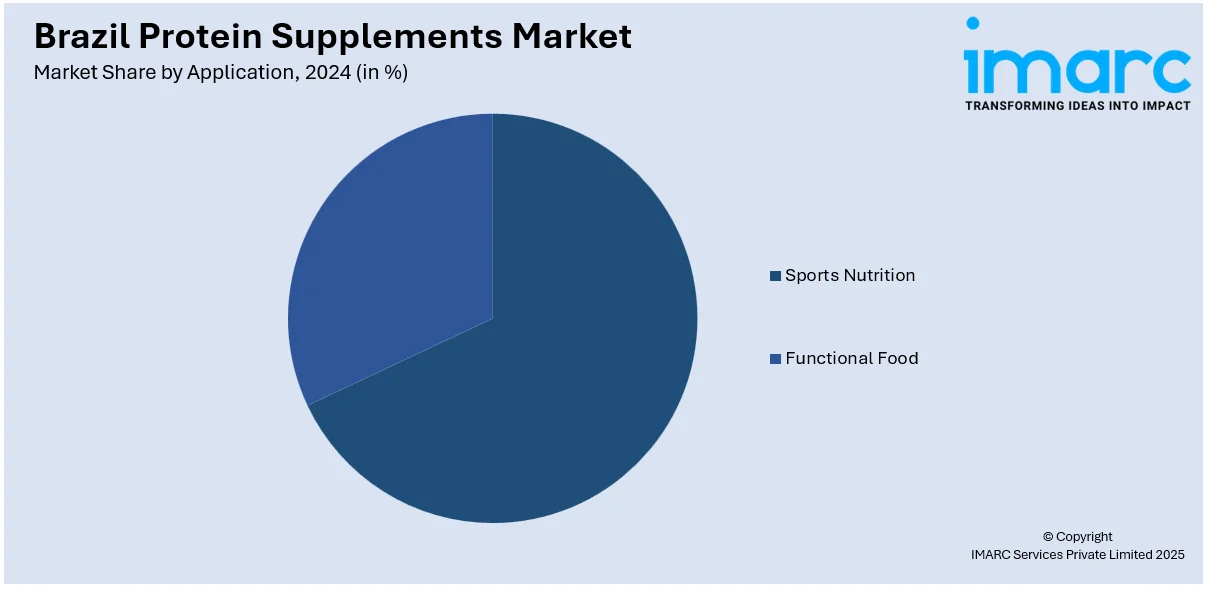
Brazil Protein Supplements Market Size, Share, Trends and Forecast by Type, Form, Source, Application, Distribution Channel, and Region, 2025-2033
Brazil Protein Supplements Market Overview:
The Brazil protein supplements market size reached USD 566.50 Million in 2024. Looking forward, IMARC Group expects the market to reach USD 998.44 Million by 2033, exhibiting a growth rate (CAGR) of 6.50% during 2025-2033. The rising health consciousness among the masses, along with the escalating demand for fitness and sports nutrition is propelling the market growth. Besides this, Brazil protein supplements market share is driven by rising trend of weight management, growing popularity of vegetarian diets and natural ingredients, and the expansion of e-commerce platforms.
|
Report Attribute
|
Key Statistics
|
|---|---|
|
Base Year
|
2024 |
|
Forecast Years
|
2025-2033
|
|
Historical Years
|
2019-2024
|
| Market Size in 2024 | USD 566.50 Million |
| Market Forecast in 2033 | USD 998.44 Million |
| Market Growth Rate (2025-2033) | 6.50% |
Brazil Protein Supplements Market Trends:
Increasing Health Consciousness
The growing consumer awareness about healthy living is driving the overall demand, shaping the Brazil protein supplements market outlook and industry growth. Many Brazilians are incorporating these products into their diets to support fitness goals, enhance muscle recovery, and improve health. In June 2024, research presented at the International Congress on Obesity projected that 48% of Brazilian adults will have obesity by 2044, with another 27% classified as overweight, totaling three-quarters of the population. As obesity and overweight rates are expected to affect nearly three-quarters of the adult population by 2044, many Brazilians are becoming increasingly conscious about the health risks associated with poor nutrition and a sedentary lifestyle, thereby catalyzing the demand for protein supplements in Brazil.

Rising Fitness and Sports Culture
The growing trend of fitness and sports activities in Brazil is propelling more people to participate in gym workouts, sports competitions, and wellness programs. This is offering numerous market opportunities to key players in the protein supplements industry. According to industry reports, Brazilian franchise Smart Fit reported 706 fitness clubs operating in Brazil at the end of the final quarter of 2023. This represented an increase in operating units of roughly 11 percent as compared to the same period of 2022. This increased enthusiasm for physical fitness and competitive sports naturally fuels the demand for protein supplements, as athletes and fitness enthusiasts look to optimize their performance and recovery. The drive toward better health and athletic success boosts the use of supplements to meet nutritional needs, thereby supporting the Brazil protein supplements market growth.
Brazil Protein Supplements Market Segmentation:
IMARC Group provides an analysis of the key trends in each segment of the market, along with forecasts at the regional level for 2025-2033. Our report has categorized the market based on type, form, source, application, and distribution channel.
Type Insights:
- Casein
- Whey Protein
- Egg Protein
- Soy Protein
- Others
The report has provided a detailed breakup and analysis of the market based on the type. This includes casein, whey protein, egg protein, soy protein, and others.
Form Insights:
- Protein Powder
- Protein Bars
- Ready to Drink
- Others
A detailed breakup and analysis of the market based on the form have also been provided in the report. This includes protein powder, protein bars, ready to drink, and others.
Source Insights:
- Animal-Based
- Plant-Based
A detailed breakup and analysis of the market based on the source have also been provided in the report. This includes animal-based and plant-based.
Application Insights:

- Sports Nutrition
- Functional Food
A detailed breakup and analysis of the market based on the application have also been provided in the report. This includes sports nutrition and functional food.
Distribution Channel Insights:
- Supermarkets and Hypermarkets
- Online Stores
- Direct to Customers (DTC)
- Others
A detailed breakup and analysis of the market based on the distribution channel have also been provided in the report. This includes supermarkets and hypermarkets, online stores, direct to customers (DTC), and others.
Regional Insights:
- Southeast
- South
- Northeast
- North
- Central-West
The report has also provided a comprehensive analysis of all the major regional markets, which include Southeast, South, Northeast, North, and Central-West.
Competitive Landscape:
The market research report has also provided a comprehensive analysis of the competitive landscape. Competitive analysis such as market structure, key player positioning, top winning strategies, competitive dashboard, and company evaluation quadrant has been covered in the report. Also, detailed profiles of all major companies have been provided.
Brazil Protein Supplements Market News:
- In June 2024, ioWhey Protein debuts in Brazil through a partnership with Nutrata. Plasma Nutrition announced Nutrata as its first international partner for IO technology. With Nutrata Plasma ioWhey now available in stores and online, Brazilians can access premium-quality whey protein.
- In April 2024, MuscleTech, a global sports supplement brand, has partnered with Trust Group for manufacturing and marketing in Brazil. Trust Group’s facility will produce NitroTech, CellTech, Hydroxycut Hardcore Elite, Clear Muscle, EuphoriQ, and other key products.
Brazil Protein Supplements Market Report Coverage:
| Report Features | Details |
|---|---|
| Base Year of the Analysis | 2024 |
| Historical Period | 2019-2024 |
| Forecast Period | 2025-2033 |
| Units | Million USD |
| Scope of the Report |
Exploration of Historical Trends and Market Outlook, Industry Catalysts and Challenges, Segment-Wise Historical and Future Market Assessment:
|
| Types Covered | Casein, Whey Protein, Egg Protein, Soy Protein, Others |
| Forms Covered | Protein Powder, Protein Bars, Ready to Drink, Others |
| Sources Covered | Animal-Based, Plant-Based |
| Application Covered | Sports Nutrition, Functional Food |
| Distribution Channels Covered | Supermarkets and Hypermarkets, Online Stores, Direct to Customers (DTC), Others |
| Regions Covered | Southeast, South, Northeast, North, Central-West |
| Customization Scope | 10% Free Customization |
| Post-Sale Analyst Support | 10-12 Weeks |
| Delivery Format | PDF and Excel through Email (We can also provide the editable version of the report in PPT/Word format on special request) |
Key Questions Answered in This Report:
- How has the Brazil protein supplements market performed so far and how will it perform in the coming years?
- What is the breakup of the Brazil protein supplements market on the basis of type?
- What is the breakup of the Brazil protein supplements market on the basis of form?
- What is the breakup of the Brazil protein supplements market on the basis of source?
- What is the breakup of the Brazil protein supplements market on the basis of application?
- What is the breakup of the Brazil protein supplements market on the basis of distribution channel?
- What are the various stages in the value chain of the Brazil protein supplements market?
- What are the key driving factors and challenges in the Brazil protein supplements market?
- What is the structure of the Brazil protein supplements market and who are the key players?
- What is the degree of competition in the Brazil protein supplements market?
Key Benefits for Stakeholders:
- IMARC’s industry report offers a comprehensive quantitative analysis of various market segments, historical and current market trends, market forecasts, and dynamics of the Brazil protein supplements market from 2019-2033.
- The research report provides the latest information on the market drivers, challenges, and opportunities in the Brazil protein supplements market.
- Porter's five forces analysis assist stakeholders in assessing the impact of new entrants, competitive rivalry, supplier power, buyer power, and the threat of substitution. It helps stakeholders to analyze the level of competition within the Brazil protein supplements industry and its attractiveness.
- Competitive landscape allows stakeholders to understand their competitive environment and provides an insight into the current positions of key players in the market.
Need more help?
- Speak to our experienced analysts for insights on the current market scenarios.
- Include additional segments and countries to customize the report as per your requirement.
- Gain an unparalleled competitive advantage in your domain by understanding how to utilize the report and positively impacting your operations and revenue.
- For further assistance, please connect with our analysts.
 Inquire Before Buying
Inquire Before Buying
 Speak to an Analyst
Speak to an Analyst
 Request Brochure
Request Brochure
 Request Customization
Request Customization




.webp)




.webp)












